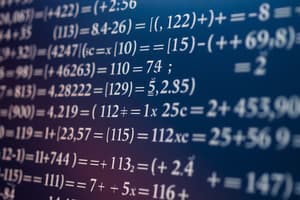Podcast
Questions and Answers
What is a best-fit line?
What is a best-fit line?
The line that most closely approximates the data in a scatter plot.
What is bivariate data?
What is bivariate data?
Data with two variables.
What is a constant function?
What is a constant function?
A linear function of the form y = b (horizontal line).
What is an identity function?
What is an identity function?
What is an inverse function?
What is an inverse function?
What is an inverse relation?
What is an inverse relation?
What is linear extrapolation?
What is linear extrapolation?
What is linear interpolation?
What is linear interpolation?
What is linear regression?
What is linear regression?
What is a line of fit?
What is a line of fit?
What is a median-fit line?
What is a median-fit line?
What are parallel lines?
What are parallel lines?
What are perpendicular lines?
What are perpendicular lines?
What is point-slope form?
What is point-slope form?
What is a scatter plot?
What is a scatter plot?
What is slope-intercept form?
What is slope-intercept form?
What is a constraint?
What is a constraint?
What is the correlation coefficient?
What is the correlation coefficient?
Flashcards
Best-fit line
Best-fit line
The line that best approximates the data points in a scatter plot, showing the overall trend.
Bivariate data
Bivariate data
Data involving two variables, allowing an analysis of their relationship.
Constant function
Constant function
A linear function of the form y = b, appearing as a horizontal line.
Identity function
Identity function
Signup and view all the flashcards
Inverse function
Inverse function
Signup and view all the flashcards
Inverse relation
Inverse relation
Signup and view all the flashcards
Linear extrapolation
Linear extrapolation
Signup and view all the flashcards
Linear interpolation
Linear interpolation
Signup and view all the flashcards
Linear regression
Linear regression
Signup and view all the flashcards
Line of fit
Line of fit
Signup and view all the flashcards
Median-fit line
Median-fit line
Signup and view all the flashcards
Parallel lines
Parallel lines
Signup and view all the flashcards
Perpendicular lines
Perpendicular lines
Signup and view all the flashcards
Point-slope form
Point-slope form
Signup and view all the flashcards
Scatter plot
Scatter plot
Signup and view all the flashcards
Slope-intercept form
Slope-intercept form
Signup and view all the flashcards
Correlation coefficient
Correlation coefficient
Signup and view all the flashcards
Study Notes
Vocabulary: Key Terms and Definitions
-
Best-fit line: Represents the closest approximation of the data in a scatter plot, showcasing the overall trend.
-
Bivariate data: Involves two variables, allowing for analysis of their relationship and interaction.
-
Constant function: Defined as a linear function of the form y = b; depicted graphically as a horizontal line.
-
Identity function: The function represented by y = x, where output equals input.
-
Inverse function: Represents the inverse relation of a given function, essentially reversing the roles of input and output.
-
Inverse relation: Comprises ordered pairs retrieved by swapping the x and y coordinates of each point in a relation.
-
Linear extrapolation: The process of projecting values beyond the established data range using a linear equation.
-
Linear interpolation: A technique used to estimate values within the existing data range through a linear model.
-
Linear regression: An analytical method that determines the precise line of fit for a dataset, often used for predictive modeling.
-
Line of fit: A graphical representation illustrating the trend of data points in a scatter plot.
-
Median-fit line: A variant of the best-fit line computed by employing the medians of the data point coordinates.
-
Parallel lines: Lines within the same plane that do not meet, characterized by identical slopes or being vertical.
-
Perpendicular lines: Lines that intersect at right angles, indicating a specific geometric relationship.
-
Point-slope form: An equation expressed as y - y1 = m(x - x1), which describes a line with slope m through a given point (x1, y1).
-
Scatter plot: A graphical depiction that illustrates the connection between two variables by plotting ordered pairs on a coordinate plane.
-
Slope-intercept form: An equation structured as y = mx + b, where m indicates the slope and b denotes the y-intercept.
-
Constraint: A specific condition or restriction that must be fulfilled by a solution in a mathematical context.
-
Correlation coefficient: A numerical value that quantifies the degree of closeness between data points and their corresponding line on a graph.
Studying That Suits You
Use AI to generate personalized quizzes and flashcards to suit your learning preferences.




